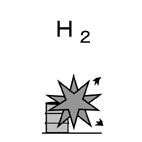| Case Name |
Explosion of hydrogen gas caused due to breakage of an exhaust gas duct at space rocket engine test facilities |
| Pictograph |

|
| Date |
May 16, 1991 |
| Place |
Kakuda, Miyagi, Japan |
| Location |
Laboratory |
| Overview |
A test for a flow meter of a high-pressure hydrogen feeding system into a burner of space rocket engine testing equipment was carried out with actual gas. Hydrogen was not burned in the burner intentionally. It was burned in a heat chamber, which was at the silencer house having passed through an exhaust gas duct and disposed of. An explosion accident happened at that time. As 132 high-temperature and high-pressure hydrogen tests were carried out during five years, the materials of the exhaust gas duct had deteriorated. The main cause of this accident found by an investigation was deterioration because of unpredictable thermal stress. However, the fact that cracks were found and repaired many times, and that the grinding portion had reached 70% (14 mm) from these cracks and repairs was not mentioned in the investigation report. Therefore, there is a possibility of an repair management error. |
| Incident |
An explosion occurred at testing equipment of a fuel-feeding system for a space rocket engine. During testing of a 42 MPa high-pressure hydrogen gas flow system, an exhaust gas duct outlet was damaged; hydrogen blew out and exploded. It seemed that the cause of this accident was deterioration of the exhaust gas duct outlet by thermal stress. High-pressure hydrogen was flowing during the test, and burned not in the burner (a gas generator), but in a silencer tower after flowing through an exhaust gas duct. This explosion was caused due to damage to that duct. |
| Processing |
Consumption and usage |
| Substance |
Hydrogen, Fig2 |
| Type of Accident |
Explosion |
| Sequence |
16:59 on May 16th, 1991; hydrogen gas flowing started during testing of a hydrogen gas flow measuring system of equipment for a space rocket engine.
(If the time that hydrogen gas started flowing is defined as 0 second,)
+5.8 seconds, after the exhaust gas duct's internal pressure reached about 22 MPa, the exhaust gas outlet duct, which was 21 cm in diameter, 91 cm in length and made of stainless steel and nickel alloy, was damaged, and hydrogen gas blew out.
+7.3 seconds, a hydrogen gas detector detected the leakage of hydrogen gas, and a breaker automatically shut. Then, after one second, blowing off of hydrogen gas stopped.
+12.9 seconds, leaked hydrogen gas exploded. A slate roof of the duct testing house blew off as far as about 160 m away. Just after that, the second explosion occurred at 200-300 m up in the sky. |
| Cause |
Nickel alloy of the exhaust gas duct welding became brittle after 132 tests of high-pressure and high-temperature hydrogen gas combustion over five years, and it broke. |
| Countermeasures |
A flange joint was installed to check the inside of the welded part, and it can be dismantled. Mother material and welding material were changed, an inner liner to prevent thermal stress was added, the limit of the frequency of the use was set, and the repair standard was reviewed. |
| Knowledge Comment |
If equipment is repaired several times, there is a possibility that its original performance might not be maintained. Sometimes the report is not credible. |
| Background |
It was considered that lack of a prior study on the exhaust duct material and thermal stress was the cause of this accident. |
| Sequel |
This duct had been used for five years and 132 tests had been carried out prior to the day of the accident. After 117 tests, some cracks were found at the inside of welded parts and at a check in August, 1990, some cracks were also found. After these cracks were removed by grinding and the equipment's strength was confirmed by a pressure-proof test, an air test, and a special test, it was used for several tests. After the repair in August, 1990, the welding thickness was the maximum of 20 mm an the minimum of 6 mm. |
| Reason for Adding to DB |
Example of explosion caused due to improper maintenance |
| Scenario |
| Primary Scenario
|
Poor Value Perception, Poor Safety Awareness, Inadequate Risk Recognition, Insufficient Analysis or Research, Insufficient Prior Research, Repeated Drastic Change, Misjudgment, Misperception, Planning and Design, Poor Planning, Inadequate Speciality, Usage, Maintenance/Repair, Failure, Degradation, Secondary Damage, External Damage, Explosion
|
|
| Sources |
Takane Kobayashi, Hydrogen explosion accident analysis of Kakuda rocket development center. Safety engineering. No.166. pp.41-50 (1992)
High Pressure Gas Safety Inst. of Japan. High-pressure gas protection overview. 1992 edition. pp.184-185 (1992)
|
| Number of Deaths |
0 |
| Number of Injuries |
0 |
| Physical Damage |
A pump testing room, a general testing room, and the gas generator turbine testing ceiling were all destroyed. Almost all measurement piping in the pump testing room received blast damage. A slate roof 50 m separated from high-pressure gas containers, and walls around the exhaust gas treatment equipment 190 m away were damaged.
Neighboring damage: eight private houses (the farthest one was about 2 km away), and one factory were damaged. At seven of the houses, windows were broken. At two of the houses, parts of walls and fixtures were moved. |
| Consequences |
A sound of the explosion was heard at a residential house 4-5 km away. |
| Multimedia Files |
Fig2.Chemical formula
|
| Field |
Chemicals and Plants
|
| Author |
WADA, Yuji (National Institute of Advanced Industrial Science and Technology)
TAMURA, Masamitsu (Center for Risk Management and Safety Sciences, Yokohama National University)
|
|